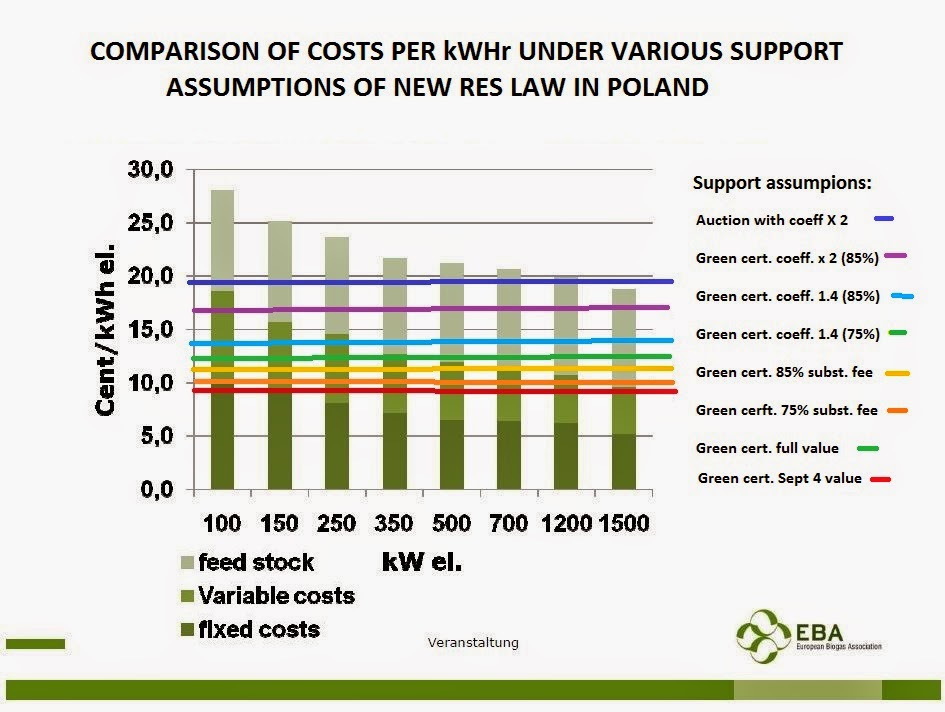Biogas Support Levels Compared to the Cost of Producing Electricity
I have put together this interesting graphic to depict what the different assumptions about support mean in the new Polish law being debated now. This does not reflect the value of heat sales or support for co-generation, which are critical to having a profitable project. It does show the relative inefficiency of smaller projects. The graphic also clearly illustrates the problem of buying substrates (such as grain or silage) and their very high contribution to the end price per kWhr.
The values used cover a variety of scenarios. The 1.4 correction factor was the original Ministry of Economy proposal. The 2 factor is slightly lower than the IEO report recommended last year. The auction value would be the reference price (maximum in the auction) which will be lower somewhat, but not significantly since there will be too few projects below 1 MW to create real competition in the bidding as the proposal now stands. It is questionable whether the Polish proposed auctions can be approved under the EU rules on competition.
Ironically, all indications are that continuing Green Certificates with direct electricity sales allowed would be the least expensive support mechanism for the public. The irony being that the Polish Government assumes auctions will always net a lower level of support (an erroneous assumption disproved by several countries experiences). The risk are increased to the developer and normally more risks mean higher prices to account for the risks.
The European Commission has estimated that 70% of the Member States have not provided enough support for biogas to be profitable. The prevalent political model has been to support farm biogas plants (normally in the 250-350 kW range). One can quickly see that this is the most expensive way to support biogas development. Pressure on RES support throughout the EU is often trimming support for biogas as well as other renewables (Polish is the exception because we were already so far south!). See red line above. But as this happens, it becomes essential to support biogas from organic wastes and larger sized plants (1-2 M W being the optimum). See HelmutDöhler and Mark Paterson, "Improvement of the technical, economical andecological efficiency of biogas production -future challenges for theagricultural engineering sector ," Club of Bologna (2012); EUAgro-Biogas, European Biogas Initiative to improve the yieldof agricultural biogas plants,"Deliverable 22 (2010).
If Poland wants to get the optimized development of biogas, that cost the least in terms of support and provides the most collateral benefits in waste management and environmental protection, then it should provide for organic waste anaerobic digestion plants from 1 to 2 MW. Allowing these plants to receive Green Certificates and to directly sell electricity to end-users also reduces the price for electricity to consumers as well.
The values used cover a variety of scenarios. The 1.4 correction factor was the original Ministry of Economy proposal. The 2 factor is slightly lower than the IEO report recommended last year. The auction value would be the reference price (maximum in the auction) which will be lower somewhat, but not significantly since there will be too few projects below 1 MW to create real competition in the bidding as the proposal now stands. It is questionable whether the Polish proposed auctions can be approved under the EU rules on competition.
Ironically, all indications are that continuing Green Certificates with direct electricity sales allowed would be the least expensive support mechanism for the public. The irony being that the Polish Government assumes auctions will always net a lower level of support (an erroneous assumption disproved by several countries experiences). The risk are increased to the developer and normally more risks mean higher prices to account for the risks.
The European Commission has estimated that 70% of the Member States have not provided enough support for biogas to be profitable. The prevalent political model has been to support farm biogas plants (normally in the 250-350 kW range). One can quickly see that this is the most expensive way to support biogas development. Pressure on RES support throughout the EU is often trimming support for biogas as well as other renewables (Polish is the exception because we were already so far south!). See red line above. But as this happens, it becomes essential to support biogas from organic wastes and larger sized plants (1-2 M W being the optimum). See HelmutDöhler and Mark Paterson, "Improvement of the technical, economical andecological efficiency of biogas production -future challenges for theagricultural engineering sector ," Club of Bologna (2012); EUAgro-Biogas, European Biogas Initiative to improve the yieldof agricultural biogas plants,"Deliverable 22 (2010).
If Poland wants to get the optimized development of biogas, that cost the least in terms of support and provides the most collateral benefits in waste management and environmental protection, then it should provide for organic waste anaerobic digestion plants from 1 to 2 MW. Allowing these plants to receive Green Certificates and to directly sell electricity to end-users also reduces the price for electricity to consumers as well.



Comments